
How

How
HGI built a 12 foot long, 1/1000 scale miniature model of the Auriga. They also built two 1/32 models to be used together--the 1/32 scale Betty and docking bay. The five foot Betty model fit within the enormous docking bay (18 feet long, 10 feet high, 9 feet deep) so that these shots could be photographed in-camera.
Hunter talked about this in-camera approach to the docking bay shots: "We would mount the Betty on a model mover, put it into the docking bay, and pretty much 'fly' it into the bay, with the model mover clearly visible. After we shot that, we would remove the model and model mover, and do the same camera move with the motion control camera in order to get a clean plate." Duboi digitally erased the previously visible model mover, and painted in its place the background, supplied by that clean plate.
Providing the intricate motion control needs for the film was General Lift, supervised by Joe Lewis. The enormity of the docking bay set necessitated the contruction of some special rigs. Lewis told me, "It was sometimes hard to rig everything, because that miniature was so huge. I had to build a couple of special devices to move the Betty up and down, when it would 'fly' in and dock with the Auriga. It had to have a wide range of movement so that the ship could realistically look like it was flying and docking."
An ever-present concern was insuring that all the miniatures would match in design with the first unit photography. Another major concern was to avoid the obvious visual cues that reveal the miniature ships' true scale. Hunter said, "We worked with Pitof and Erik Henry on deciding the scales to which the ships should be built. We were hoping to integrate some of the miniatures so that they would work together in the same scale. For instance, for the sequence when the Betty ship docks with the Auriga, we built both the ship and the bay in the same scale so we could photograph them together."
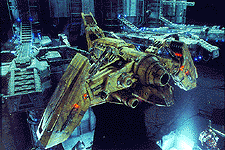
The top image is a frame from the original photography. Notice the model mover supporting the Betty, and the lights illuminating it from below. The bottom image is the final composite, with the model mover erased.
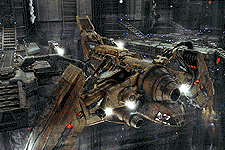
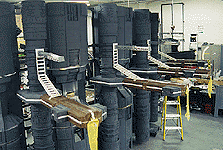 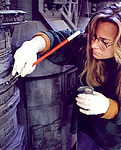
At left, construction of the HGI model of the docking bay in progress. At right, HGI's Leigh Alexandra Jacob gives the interior docking bay a detailed paint job. |
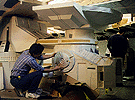 HGI model maker Jim Key works on a section of the miniature Observation Room. |
Another sequence that featured full-frame miniatures was the observation room scene, where a scientist sits in a revolving observation booth, looking at the aliens in their own surrounding compartments. Gratzner said, "the miniature of the observation room was built in 1/6 scale. It had to match the full scale set that was only partially built--in real life, as it was designed, the set would span over 180 feet. So we built our miniature room at 1/6 scale, which made the set about 30 feet long and seven feet tall."
Gratzner remarked about the full-frame miniature sequences: "One of the things that made us extremely happy to work on the film was that there are shots whose frame is completely filled with our miniatures. The docking bay, the observation room, the miniatures are right there in front of you, full frame, with a few actors comped in front of them. That was a unique situation, which we were happy to be a part of."


. . VFX HQ Produced by Todd Vaziri . . http://www.vfxhq.com . . e-mail: tvaziri@gmail.com . .
All text Copyright © 1998 Todd Vaziri, unless otherwise noted